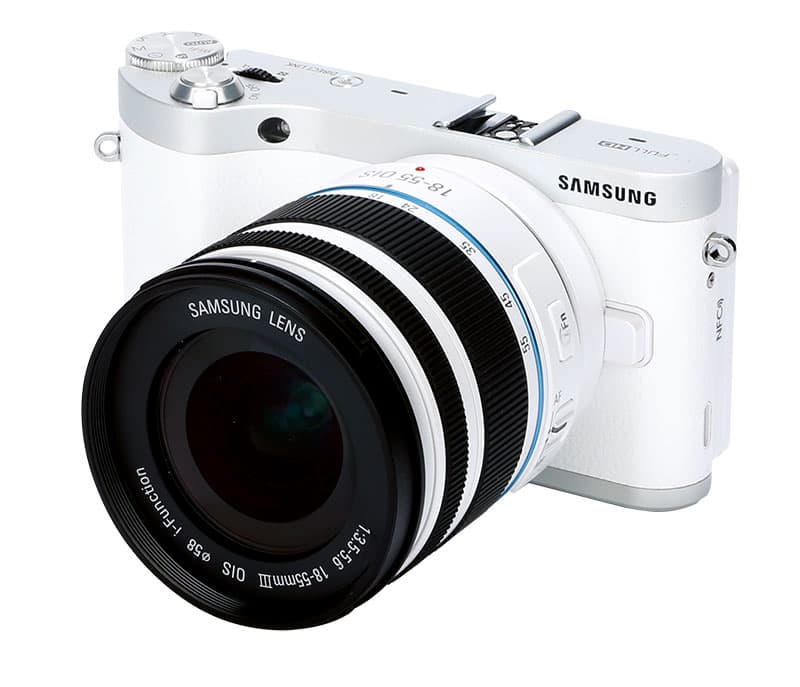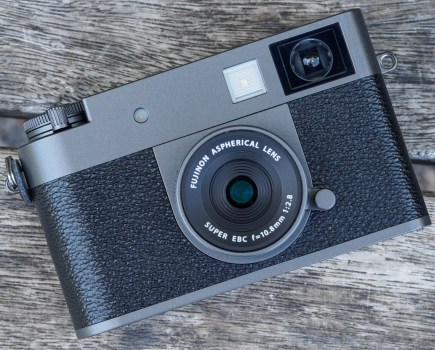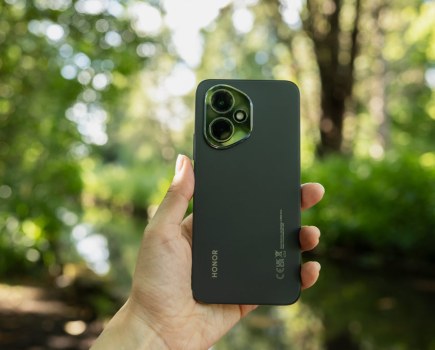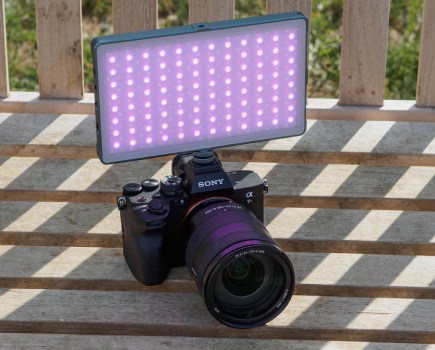Samsung NX300 at a glance:
- 20.3-million-pixel, APS-C CMOS sensor
- DRIMe IV image processing engine
- Hybrid AF system
- Dual-band Wi-Fi
- 3in rear tiltable LCD touchscreen
- Street price £599, supplied with full version of Adobe Lightroom and 20-50mm lens
Samsung NX300 review – Introduction
Samsung has been an active presence in the photography market over the past few years. In fact, the company’s established position in electronics, particularly the smartphone sector, has been used to good effect in its NX series of compact system cameras. The company has led the way when it comes to features such as a built-in Wi-Fi, and small cameras with good connectivity are popular at the moment. The new Samsung NX300 is the fourth instalment in a viewfinder-less CSC line, replacing the NX210.
At first glance, it appears that only subtle changes have been made to the Samsung NX300 since the earlier NX210. But dig a little deeper and many more significant improvements come to light, such as a new sensor, AF system, processor and rear screen.
Samsung has also been busy working on its lens range, and the NX lens mount now comprises 12 lenses plus a number of third-party optics. During my test of the NX300, I used the 18-55mm III f/3.5-5.6 kit lens, plus the 18-200mm f/3.5-6.3, 16mm f/2.4 pancake, 60mm f/2.8 macro and 85mm f/1.4 lenses. A new 45mm f/1.8 2D/3D model was also announced alongside the launch of the camera. The NX300 therefore looks to have a strong feature set that is backed up by some good lenses.

Samsung NX300 review – Features
Like its predecessor, the NX300 uses a 20.3-million-pixel, APS-C-format Samsung sensor, but it is not the same unit as that found in the NX210. With a new DRIMe IV image-processing engine also fitted, the Samsung NX300 has a 1-stop increase in sensitivity range over the NX210 to ISO 100-25,600. From Samsung’s specification, we can expect to see an improvement in the low-light performance of the new model.
A maximum output of 5472×3648 pixels equates to 18x12in prints at 300ppi, although at 240ppi prints closer to A2 are possible. Samsung supplies the camera with a full version of Adobe Lightroom 4.4, which is an excellent inclusion and adds considerable value to the kit for those who do not already own this software.
Built into the sensor are 105 phase-detection pixels, to create a hybrid AF system similar to that in cameras such as the Canon EOS 650D and Fujifilm X100S. This means the NX300 uses both phase and contrast-detection AF, automatically switching between the systems according to the camera settings and the scene being captured. More on this later.
Built-in Wi-Fi was introduced in the NX210, which was effectively the same camera as the NX200 but with the Wi-Fi addition. The NX300 also offers Wi-Fi, but with some added functions and improved operation. On the new model, Wi-Fi has its own place on the shooting-mode dial so it can access apps such as Remote Viewfinder and Mobile Link. We went into detail about these remote-control and image-sharing apps in the review of the Samsung NX210 (AP 21 July 2012). For more details on the improvements and what is possible with Wi-Fi in the NX300, see Built-in Wi-fi. Like the NX210, the NX300 can geotag GPS data onto image files, but through the optional GPS10 GPS module, which currently is hard to come by.
The several auto shooting modes include 14 smart effects. Contained in the smart menu are modes such as panorama, rich tones and waterfall. A lens-priority mode makes use of a lens with the i-Fn button, through which a beginner-friendly slider for depth of field can be accessed to make quick changes to the aperture.
With a continuous high frame rate of 8.6fps and continuous low frame rate of up to 5fps, the NX300 should be able to capture a sequence of images of fast-moving subjects. There is a JPEG-burst-only mode, too, for shooting at 10fps, 15fps and 30fps but, with raw format selected, a burst lasts for less than 1sec. It is only in reduced JPEG-quality-only capture that a burst long enough to truly capture a subject is possible, up to around 20 frames. This performance is, however, an improvement over the NX210.

Images: There is a good choice of lenses that cover a variety of subjects. The goat image has been taken with the 85mm f/1.4 lens, which enables a shallow depth of field while providing crisp results. The deer image was taken with the 18-200mm lens at its telephoto setting. Detail is not as crisp, but the reach of the lens means one can stand far off from the subject
Samsung NX300 review – Built-in Wi-fi
Wi-Fi has received a lot of coverage in camera tests recently, but it deserves mention here due to the number of possibilities in the NX300. First, the support has been improved, with dual-channel (band) IEEE 802.11b/g/n rather than the IEEE 802.11n in the NX210.
Autoshare is new in the NX300 and automatically loads images to a paired device. Also new is Near Field Communication (NFC) – a technology that provides a more straightforward Wi-Fi connection between NFC-enabled devices such as cameras, tablets and smartphones. There is also a new app, called Samsung Smart Camera, which covers both existing Mobile Link and Remote Viewfinder apps.
With Samsung’s electronics background, it is hardly surprising that Wi-Fi, on the whole, works very well in the NX300. There is a bit of a lag in the display of Remote Viewfinder, and I had trouble making a direct connection in some situations with a Motorola phone, but this proved easier with an iPhone/iPad and no real issues at all with a Samsung phone. There is a drain on the camera battery, though, which is a problem given that the battery life is modest already.

Image: This set-up shows the Remote Viewfinder app, through which control of the camera can be taken using a smartphone or tablet
Samsung NX300 review – Build and handling
The exterior of the NX300 looks much the same as its predecessor, apart from a handful of welcome improvements. Made around a similar design to the NX210, the shape and size of the new model is virtually the same, which means the NX300 is not the smallest CSC around but it is compact nonetheless. The NX300 is marginally deeper, mostly due to its new tiltable LCD screen, although the added depth is a worthy trade-off for the tilt function that enables clearer viewing of the screen from high and low angles.
Externally, the main change to the body is the leather-effect textured front panel, and I much prefer this new look. The camera is available in black, white or brown versions, with each having a brushed metal top-plate. The NX300 is the most stylish NX camera to date, with the white version having a modern appeal while the black and brown versions echo the look of old, but in a modern curvy form. The curved grip looks great, but more importantly it is comfortable to hold firmly, especially with the redesigned thumb grip on the camera’s rear.
There have been a few tweaks to the button layout, but those familiar with the NX210 will feel right at home with the new model. Instead of a control wheel on the rear, the NX300 has a four-way D-pad. There is less need for a control wheel on the new model given that the rear screen is a touch type and can be used for scrolling through menus and to view images – more on the screen later. A new direct-link button on the top-plate initialises auto-share, which automatically uploads images to a smart device immediately after they are shot.
Some of the NX lenses are quite big and weighty relative to the size of the camera. This is particularly true of the 85mm f/1.4, which is better suited to the larger NX20. However, the three pancake lenses complement the size of the camera well, and the 18-55mm kit lens is well balanced with the camera.
The start-up time of the NX300 is fast and it shoots well inside 2secs. Shutter lag when using the shutter button is negligible, too, although there is a slight lag when using the touchscreen. The fastest shutter speed of 1/6000sec is 1⁄2 stop quicker than most of the competition, while the bulb mode has a maximum exposure time of 4mins.
Battery life can only be described as poor, especially when any of the Wi-Fi functions are activated. During one morning out in sub-zero temperatures, the battery was dead within two hours after around 175 photos had been captured. Under CIPA testing standards, measured life is up to 320 shots, though, which is a fraction less than the NX300’s competitors.
Samsung NX300 review – LCD, viewfinder and video
The NX300’s rear LCD screen can tilt up approximately 90° and down 45°, whereas the screen in the NX210 is fixed. The display of the new screen is physically larger, too, at a class-leading 3.3in and with an improved 768,000-dot resolution. Being an AMOLED type, the screen has a bright, crisp display for a camera at this level. The clarity of display is hindered somewhat by reflections, and it is not quite as bright and colourful as the screen in, for example, the Nikon D7100, but it is crisp nonetheless and notably brighter than its predecessor.
More significant is the fact that the AMOLED screen is a capacitive touch type. I would expect a touchscreen from Samsung to work very well given the company’s strong smartphone line-up, and I am not disappointed. Being able to release the shutter, and focus, navigate menus and view images via touch, speeds up the camera’s handling. All in all, the screen is a significant improvement over its predecessor.
As the company’s more compact CSC, the NX300 does not include a viewfinder, or an accessory port in which to theoretically attach an electronic one. Despite its diminutive size, I did still occasionally find myself lifting the camera to my eye by mistake, only to be blinded by the rear screen! Most other competing models of a similar size at least offer an accessory port and optional EVF, as did the Samsung NX100, so perhaps the company will develop a new EVF unit and reintroduce the accessory port next time round.
A dedicated button to record video files is conveniently placed next on the thumb grip. Full HD 1080p videos can be captured at 60fps, 30fps and 24fps at 1920×810-pixel resolution, with stereo sound.
Samsung NX300 review – Autofocus
The NX300’s hybrid AF system is made up of 105 phase-detection points that cover a wide AF area, which is more of a 16:9 ratio, while the 247 contrast-detection points cover the entire frame.
In strong continuous light and for subjects of good contrast, AF is near instant, latching onto the subject in a single motion (hunt). However, while using the camera in low light at dawn to photograph deer, I found autofocus a bit hit and miss. When using the shutter button to activate AF and the shutter, the camera sometimes did not focus at all on the subject and captured a blurry result. The success ratio was better when using touch AF on the rear screen instead.
Touch AF is a very welcome new feature. Given that the 247 contrast-detection points cover the entire frame, one can press anywhere on the screen for a spot focus. This is not only a more accurate method of focusing, but also a quicker one.
There is a difference in the AF speed of the NX300 compared to the NX210. With the two cameras set up side-by-side, AF speed was similar in good light, with the NX300 just edging it. In low-contrast light the cameras have a similar success ratio, but the NX300 is quicker again. The margins are minute, though. For another comparison, the Nikon D7100 DSLR, which uses phase-detection AF, is significantly quicker and more accurate when used in low light.
A handy tool for manual focusing is focus peaking. This feature is now present in a few cameras and works by displaying high-contrast edges around the point of focus. In the NX300, peaking is viewed on the rear screen in either white, red or green, with options for three levels of strength for varying degrees of focus. There is also MF assist, which enlarges the frame up to 8x for a closer look at the focus point.
Samsung NX300 review – Metering
The NX300 uses the same 221-segment metering system as the NX200 and NX210. The multi-segment metering mode provides even exposures in most situations, and I found little need to dial in exposure compensation for day-to-day shooting.
Thanks to the camera’s touchscreen, spot metering is much quicker to operate and therefore more appropriate for a wider number of shooting situations. In practice, spot metering is usually appropriate only when one has the time to move the spot to the correct area of the frame, but by using the touchscreen there is much quicker response. With this in mind, I found myself switching between multi and spot metering more than I normally would. Spot metering can be linked to the AF point, so a simple touch of the screen can operate focus, metering and shutter in one go, anywhere in the frame.
Samsung NX300 review – Dynamic range
The NX300 has a dynamic range approaching 13EV, which is impressive for a mid-priced CSC. In standard shooting mode there is a wide range of tones. There is plenty of tonal detail in scenes where there is a high level of contrast, such as in bright skies and in midtone areas such as trees in a landscape.
There is now a Dynamic Range option in the camera’s main menu where previously it was called Smart Range. In raw capture, the Smart Range+ option within Dynamic Range can be selected to give tonal detail a boost – as seen in the brightening of shadow areas and the darkening of top highlights. Smart Range+ is an auto setting, as there are no levels of strength from which to choose, but fortunately it does a good job, giving a subtle lift to tones.
Also in the Dynamic Range menu is the HDR shooting mode. Again, this is auto only, with no manual control over its strength. HDR is new to the NX300. It is available in JPEG capture only, and on the whole the effect is not to my liking. Tonal detail is flat where the shadow and highlight areas are boosted too much, while the colour saturation is not enhanced enough. Consequently, having used the Dynamic Range modes a little, I opted to switch them off. Perhaps Samsung could include manual control over the strength of these modes in its next model.
Samsung NX300 review – White balance and colour
 Image: Shot in the standard colour mode, colours are very natural in this sunny scene
Image: Shot in the standard colour mode, colours are very natural in this sunny scene
I was impressed by the colour rendition of images straight out of the camera. In the standard shooting mode, colours are natural rather than oversaturated, but not dull. With Picture Wizard turned on, there is the choice of nine modes, from the usual standard and vivid settings to the more unusual forest and calm. There are a further three custom settings. With the vivid mode activated, colour saturation is given a boost but it is not garish. So, for those who like a bit of punch to their images, vivid is a good choice. The black & white mode is called classic. Unfortunately, unlike some other cameras, there is no option for b&w filter effects.
The NX300 has the usual complement of white balance presets, auto, custom and manual Kelvin adjustments. A custom reading is quick to take. AWB is, on the whole, accurate, apart from the usual situations where it cannot compensate against dominate tones in a scene.
The NX300 offers three-frame bracketing for Picture Wizard and white balance, with manual control over the three chosen settings. Both bracketing modes are available in JPEG only, which, for those who like to shoot in raw format, will be somewhat redundant as changes to the colour can be made post-capture. Changes can also be made in-camera to hue and saturation, among other things.
Samsung NX300 review – Noise, resolution and sensitivity
 Image: Even at ISO 100, there is some luminance noise in shadow areas, but it is uniform so detail still looks crisp
Image: Even at ISO 100, there is some luminance noise in shadow areas, but it is uniform so detail still looks crisp
With the same 20.3-million-pixel resolution as its predecessor, the NX300 resolves an impressive level of detail in good light. In both raw and JPEG format at ISO 100, the camera reaches the 32 marker when using the 85mm f/1.4 lens, which is up there with the best models in its class. The 18-55mm kit lens resolves slightly less detail, up to the 30 marker. A direct comparison of a raw and a JPEG file shows, unsurprisingly, that detail is a little softer in JPEGs.
With a new processor and an increase in sensitivity range by 1 stop up to ISO 25,600, the NX300 resolves detail better in low light than its predecessor, which was relatively poor against its competition. At ISO 12,800, the new model reaches up to the 24 marker. The reason that resolved detail is better in low light is that the NX300 has better control over noise at these settings.

Image: An overall dark exposure was needed here to keep the highlight detail. Brightening the exposure +3EV reveals limited detail in shadow areas that can be prone to chroma noise
Luminance noise is present at all ISO sensitivities in midtone and shadow areas, but is less obvious in highlight areas. Images taken at ISO 100 are still clean, though, and markedly more than those at ISO 800, where noise begins to turn less uniform. However, images all the way up to ISO 6400 are usable.
Chroma noise is often present in shadow areas in particular. This is seen mostly in red pixels, but also in some green and blue stray pixels. The effect of chroma noise can be seen more clearly if a dark exposure is brightened, but it can be dealt with easily using the supplied Adobe Lightroom.

These images show 72ppi (100% on a computer screen) sections of images of a resolution chart, captured using the 85mm f/1.4 lens set to f/5.6 . We show the section of the resolution chart where the camera starts to fail to reproduce the lines separately. The higher the number visible in these images, the better the camera’s detail resolution is at the specified sensitivity setting.
Samsung NX300 review – The competition
 Both Sony and Samsung compact system cameras are APS-C format. By price and specification, the Sony NEX-6 is the most similar to the NX300. There are some excellent four thirds-format CSCs in this price bracket, too, such as the Olympus Pen E-PL5.
Both Sony and Samsung compact system cameras are APS-C format. By price and specification, the Sony NEX-6 is the most similar to the NX300. There are some excellent four thirds-format CSCs in this price bracket, too, such as the Olympus Pen E-PL5.
With 20.3 million pixels, the NX300 outresolves the 16.1-million-pixel NEX-6 and Pen E-PL5. All three cameras are of a compact style, with the NEX-6 the only one with a built-in viewfinder. The E-PL5 has an accessory port for an optional EVF, but the NX300 offers neither. All have tiltable rear LCD screens, with the E-PL5 and NX300 being touch-sensitive. The E-PL5 does not have built-in Wi-Fi, but it does have a compatible external unit. All three cameras are small and light, with the NX300 the lightest and the E-PL5 the smallest.
Samsung NX300 review – Our verdict
On the whole, the improvements to the NX300 are incremental rather than radical. However, as the NX210 was already a very good camera, the same can be said of the NX300. The new model is more stylish when viewed from the front and top. Handling is improved through the LCD screen, which is a fantastic touch-enabled unit with a large, bright display. However, I would still like the option of an electronic viewfinder next time round.
Samsung’s Wi-Fi feature works very well and the novelty of what it is capable of has not worn off yet, especially the remote control of the camera’s shutter and AF. However, despite the change to the AF system, it is difficult to see any real benefit in its speed. Even with a quicker processor, the NX300 is perfectly fine for everyday use rather than sports.
Image quality is very good, especially using a lens such as the 60mm f/2.8 macro, while colour rendition is natural. In low light, the NX300 is also improved, with better control of noise. All in all, the NX300 has taken a great step to being the complete package.

Samsung NX300 – Key features
Flash
The NX300 does not have a built-in flash. However, it comes supplied with the SEF8A unit that attaches to the hotshoe port and has an output of GN 8m @ ISO 100. Other optional external flash units are also available.
In-camera editing
There are a number of changes that can be made to an image in-camera, including cropping and resizing, adding a smart filter like vignetting and miniature and, as previously mentioned, colour alterations such as temperature, exposure and contrast.
Function button
This button accesses a quick menu. From here, changes can be made to most of the key exposure controls, including some that do not have direct access elsewhere, such as white balance, metering and Picture Wizard.
NFC
The Near Field Communication chip is on the left side of the camera. Physically swiping an NFC device over the NFC chip in the NX300 activates a direct connection rather than trawling through menus.
Touchscreen
The user can choose between the touchscreen and the rear buttons to make adjustments in-camera. The touchscreen works well and over time is likely to be used just as frequently as the buttons.
i-Fn
An 18-55mm f/3.5-5.6 OIS III lens can be bought as a kit with the camera, and like many of the new Samsung lenses it has an i-Fn button. This control allows the focus ring on the lens to adjust other settings, such as aperture.
Connectivity
Underneath a hard plastic door are the mini-HDMI and mini-USB ports. The NX300 charges through the USB port rather than being supplied with a separate charger unit.

Image: With a high-resolution sensor, there is plenty of details in full-size images, as seen in the pull-up of the rock







